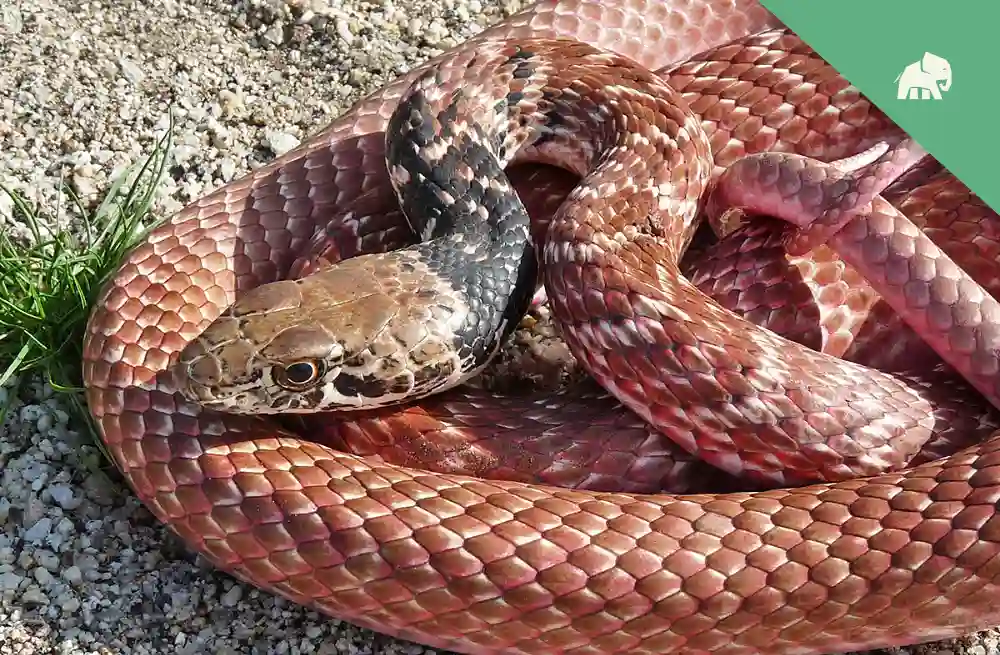The American bison (Bison bison), also known as the American buffalo, is a large mammal that is native to North America. It is one of the most iconic and recognizable animals on the continent, and has been an important cultural and economic resource for many indigenous peoples and European settlers alike.
Historically, American bison populations numbered in the tens of millions, but they were nearly hunted to extinction in the late 19th century as European settlers moved westward and sought to eliminate the bison as a means of controlling indigenous populations and opening up grazing lands for cattle.
Today, there are estimated to be around 350,000 American bison in North America, with most living in protected areas such as national parks and reserves. They are an important symbol of conservation and the preservation of North America’s natural heritage, and continue to be a beloved and revered animal among many cultures.
| Category | Details |
|---|---|
| Kingdom | Animalia |
| Phylum | Chordata |
| Class | Mammalia |
| Order | Artiodactyla |
| Family | Bovidae |
| Genus | Bison |
| Species | Bison bison |
| Niche | Large herbivores, maintaining the health and diversity of grasslands |
| Height at Shoulder | 5-6.5 feet (1.5-2 m) |
| Weight | 900-2,200 pounds (400-1,000 kg) |
| Lifespan | Up to 20-25 years |
| Social Structure | Herd animals, living in groups ranging from a few individuals to several dozen |
| Conservation Status | Near-threatened (NT) by the IUCN Red List |
| Preferred Habitat | Grasslands, prairies, and forests in North America |
| Average Offspring | 1 calf per year |
| Main Food Items | Grasses, sedges, and other plants |
| Predators | Wolves, grizzly bears, and humans (historically) |
Anatomy and Physical Characteristics of the American bison
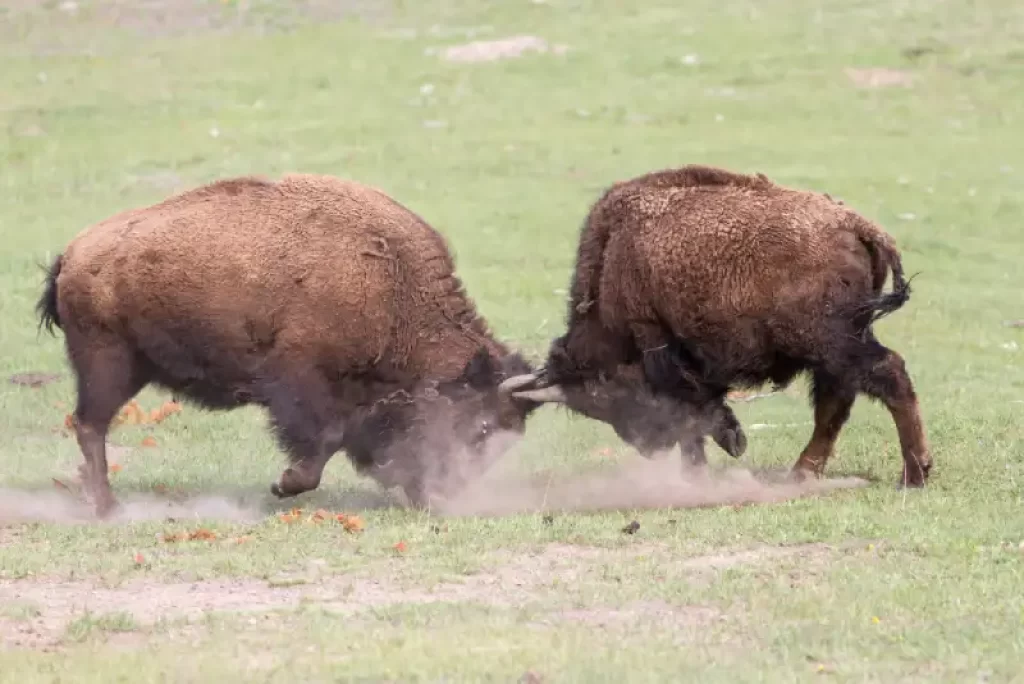
The American bison is a large and impressive animal with several distinctive physical characteristics:
Size:
The American bison is one of the largest land mammals in North America. Male bison, or bulls, can weigh between 1,000 and 2,200 pounds, while females, or cows, typically weigh between 800 and 1,000 pounds. They can stand up to six feet tall at the shoulder and are typically nine to 11 feet long from nose to tail.
Fur:
Bison have a thick, shaggy coat of fur that can be up to 12 inches long during winter. The fur is a dark brown color, and their face, neck, and shoulders are covered with shorter hair.
The fur is typically a dark brown color, although it can also be gray or black in some individuals. The face, neck, and shoulders of the bison are covered in shorter hair, which is often lighter in color.
The texture of the bison’s fur can vary depending on the season. During the winter months, the fur is dense and shaggy, providing maximum insulation against the cold. In the summer, the fur is shorter and lighter, helping the animal to regulate its body temperature more effectively.
The fur is an important adaptation for bison living in the harsh prairie and grassland environments of North America. The thick coat helps to protect the animal against extreme weather conditions, as well as providing camouflage against predators.
Hump:
One of the most distinctive features of the bison is the large hump of muscle on their shoulders.
The hump is formed by a large mass of muscle that sits on the bison’s shoulders. This muscle is used to support the bison’s massive head, as well as to power the animal’s digging motions when searching for food in snow or soil.
The hump is primarily composed of longissimus dorsi muscle, which runs along the spine from the neck to the lower back. This muscle helps the bison to maintain good posture and provides the power needed for movement.
The size of the hump can vary depending on the age, sex, and overall health of the bison. Adult bulls typically have larger humps than cows, as their larger size and heavier heads require more muscle power to support.
The hump serves as an important adaptation for bison living in the harsh prairie and grassland environments of North America. During the winter months, bison can use their powerful muscles to plow through deep snow in search of the grasses and other vegetation they need to survive.
Horns:
Both males and females have horns, but the size and shape can differ. Male horns are typically thicker, longer, and more curved than female horns. They can grow up to two feet long and weigh as much as 30 pounds.
Bison use their horns for a variety of purposes. Males will often use them to establish dominance over other males during mating season, by clashing their horns together in a show of strength. Both males and females will also use their horns to defend themselves against predators, such as wolves and grizzly bears.
The horns are made of a bony core covered in a sheath of keratin, which is the same material that makes up human hair and nails. The keratin sheath is constantly growing, and bison will often rub their horns against trees or rocks to help wear it down.
The horns are an important part of the bison’s anatomy and are believed to have evolved as a defense mechanism against predators. However, they can also be a liability for the animal, as they can become entangled in brush or fencing, and can make it difficult for the bison to maneuver in tight spaces.
Hooves:
Bison have cloven hooves, which means that their hooves are split into two parts. This adaptation allows them to walk on a variety of different terrains, including grasslands, prairies, and rocky areas.
The two parts of the hoof are called the “claws,” and they are made of a tough, keratinous material. The claws are used for gripping and digging, and are adapted for use in different types of terrain.
The shape and size of the bison’s hooves can vary depending on the sex and age of the animal. Bulls typically have larger hooves than cows, and older animals may have more heavily worn hooves due to years of use.
The bison’s hooves are an important adaptation for living in the grassland and prairie environments of North America. They are able to navigate through snow and other types of terrain, and can dig through the snow to find vegetation to eat during the winter months.
Some interesting facts about the American bison
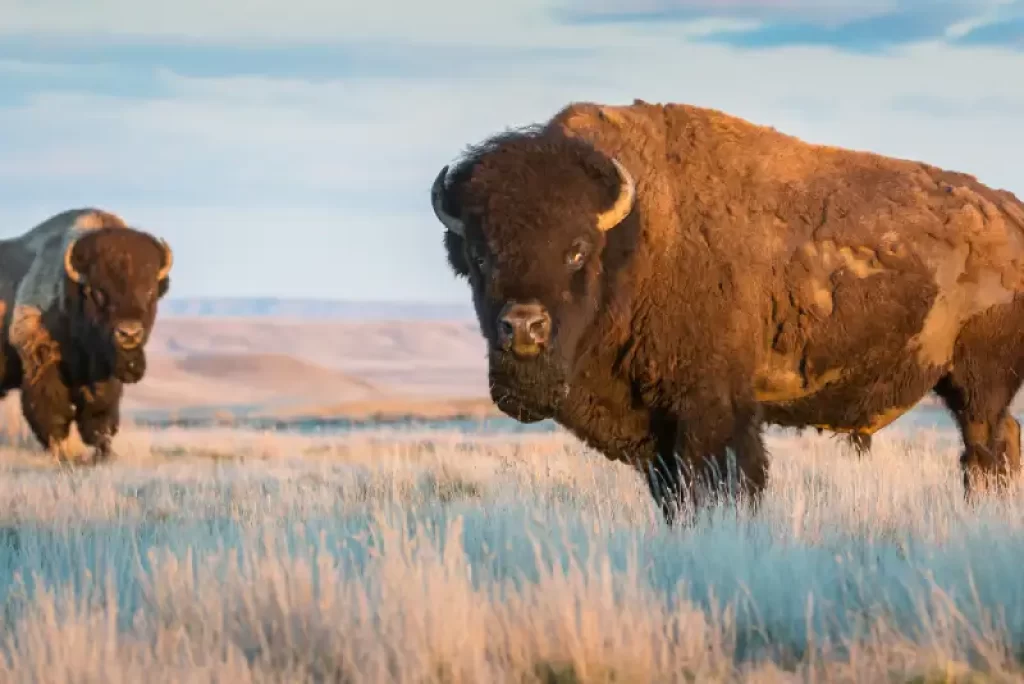
- The American bison is the largest mammal in North America. Adult males, also known as bulls, can weigh over 2,000 pounds and stand over six feet tall at the shoulder.
- The bison was once a keystone species in North America, with an estimated population of 30 to 60 million animals prior to European settlement. However, by the late 1800s, hunting and habitat loss had reduced the population to just a few hundred animals.
- Today, thanks to conservation efforts and the establishment of protected areas, the American bison population has rebounded to an estimated 350,000 animals. However, the species still faces threats from habitat loss, disease, and climate change.
- Bison are herbivores and graze on a variety of grasses, sedges, and other vegetation. They can eat up to 30 pounds of food per day.
- Bison have a long lifespan, with some individuals living up to 25 years in the wild.
- Bison have poor eyesight but an excellent sense of smell, which they use to detect predators and other animals in their environment.
- The bison is the national mammal of the United States, and it is an important cultural and spiritual symbol for many Native American tribes.
- The bison is a keystone species, playing an important role in the ecosystem by maintaining grassland habitats and providing food and shelter for other animals.
- Bison are known for their strength and agility, and can run at speeds of up to 35 miles per hour.
- Bison are social animals and live in herds, which are typically led by dominant bulls. During the breeding season, bulls will compete for the right to mate with cows.
You might also like: Bison vs. Buffalo: What’s the Difference?
Habitat and Range of the American bison
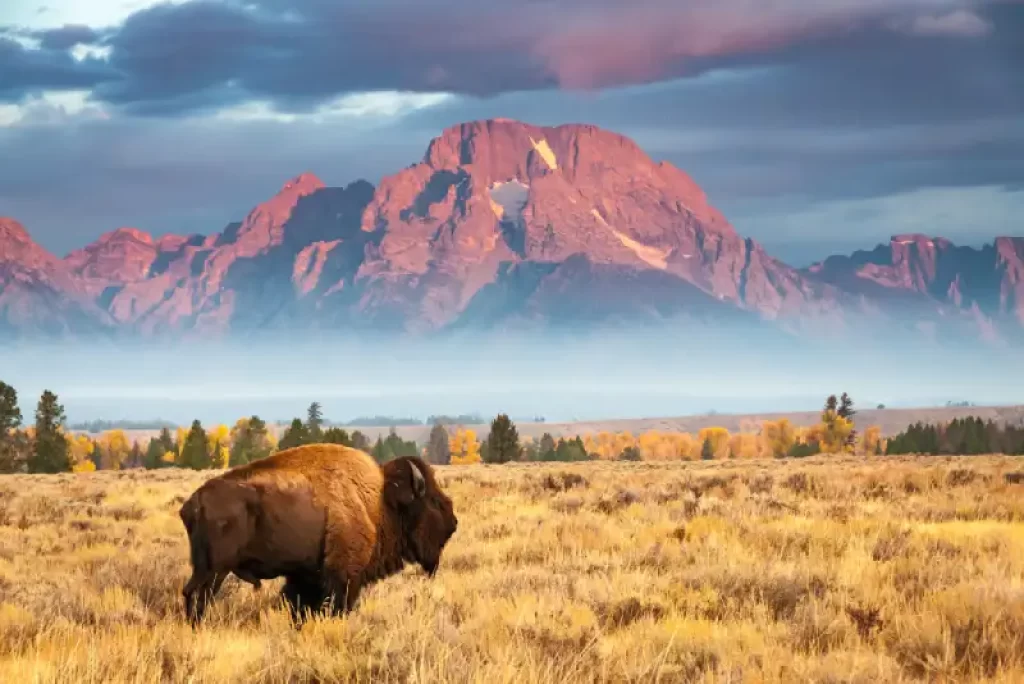
The American bison (Bison bison) is native to North America and historically ranged from Alaska down to northern Mexico, and from the Atlantic Ocean to the Rocky Mountains. Their habitat consists of grasslands, prairies, and savannas.
Today, the bison’s range is much more limited, with most of the population living in protected areas such as national parks and private ranches. Some herds have been reintroduced to their historic ranges in certain parts of the United States, such as Yellowstone National Park and the Great Plains.
Bison are well adapted to grazing on tall grasses and can also survive in harsh winter conditions, as they use their large heads to clear snow to access grasses underneath. The availability of water is also important for bison, and they will often congregate around water sources such as rivers, streams, and lakes.
Behavior and Lifestyle of the American bison

Here are some key behaviors and lifestyle characteristics of the American bison:
Social structure:
Bison are social animals and live in herds, which can range in size from a few individuals to thousands. Herds are typically made up of females and their young, with adult males living either alone or in smaller groups. The social structure of bison herds is based on a dominance hierarchy, with older, larger males typically occupying the highest ranks.
Dominant males have the best access to mating opportunities, and may defend their territory and herd from other males. Females also establish dominance hierarchies, and may compete for access to resources such as food and water. Bison herds are highly mobile, and may travel long distances in search of food and water.
Grazing behavior:
Bison are herbivores and feed primarily on grasses, though they will also eat other vegetation such as leaves and stems. They graze for several hours each day and may cover long distances in search of food.
Mating and reproduction:
During mating season, which typically occurs in the summer months, adult male bison compete for the attention of females by engaging in vocalizations and physical displays such as pawing the ground and thrashing their heads. Dominant males may also engage in physical fights with other males to establish dominance and attract females.
Female bison have a gestation period of around 9 months, and typically give birth to a single calf in the spring or early summer. Calves are able to stand and walk within an hour of being born, and are able to nurse from their mothers for several months. Females will typically nurse their calves for up to 8 months, at which point the calf is weaned and starts to eat solid food.
Bison reproduction is a slow process, as females only give birth to a single calf every 1-3 years. This means that bison populations are slow to recover from declines or disturbances, which can make them vulnerable to threats such as hunting and habitat loss.
Migration:
Bison are known to migrate seasonally in search of food and water. They typically move to higher elevations in the summer, where food and water are more abundant, and then move to lower elevations in the winter to avoid deep snow and find shelter.
Bison can cover long distances during their migrations, sometimes traveling hundreds of miles. These migrations were once a key part of the bison’s natural behavior, and helped to shape the ecology of the grasslands of North America.
Today, however, many bison herds are confined to smaller areas due to habitat fragmentation and human development.
Temperament:
Bison are usually calm and gentle, but they can be unpredictable and aggressive if they feel threatened or provoked. This is especially true during the breeding season, when males may become more aggressive in order to compete for mates. When threatened, a bison may lower its head, snort, paw the ground, and charge.
It’s important to keep a safe distance from bison and to avoid approaching them, especially during the breeding season or when they have young calves with them.
Conservation status:
Bison were once hunted to near extinction in North America, but have since rebounded due to conservation efforts. They are currently classified as a species of “least concern” by the International Union for Conservation of Nature.
Communication
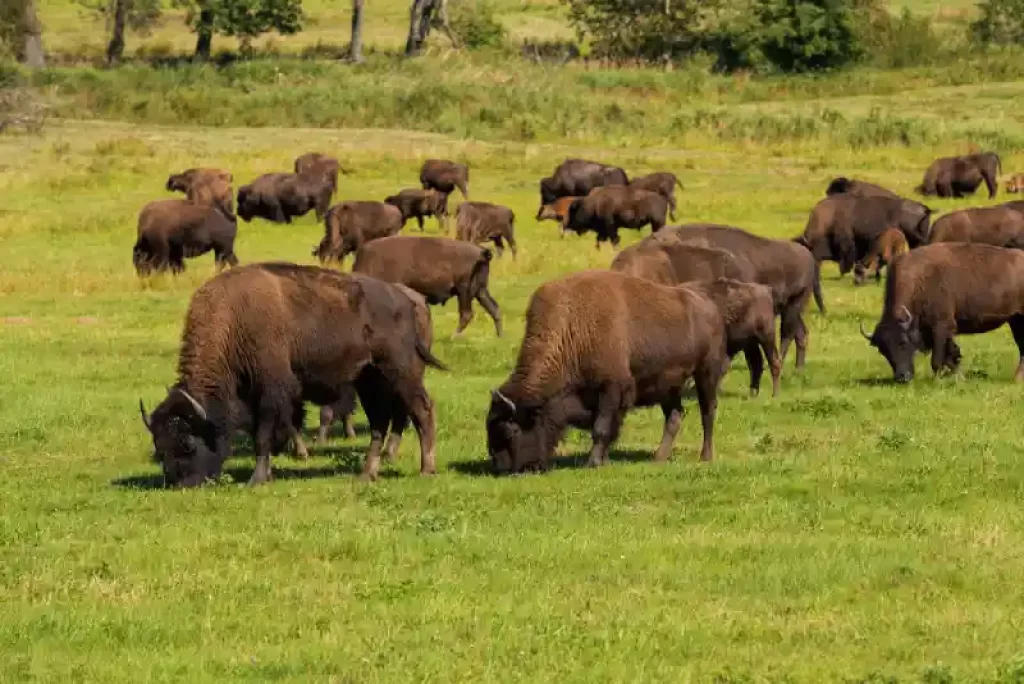
Bison communicate with each other using a variety of methods, including vocalizations, body language, and scent marking. Here are some examples:
Vocalizations:
Bison can produce a range of vocalizations, including grunts, snorts, and bellows. These sounds are used to communicate with other members of the herd, and may convey information about dominance, aggression, and mating.
Body language:
Bison use a variety of body language cues to communicate with each other, such as head shaking, ear flicking, and tail wagging. Dominant males may use their body language to assert their dominance over other males and attract females.
Scent marking:
Bison also use scent marking to communicate with each other. Males may use their urine and feces to mark their territory and attract females, while females may use their urine to signal their reproductive status to males.
Overall, communication is an important part of bison social behavior, and helps to maintain social cohesion within the herd.
Diet and Nutrition
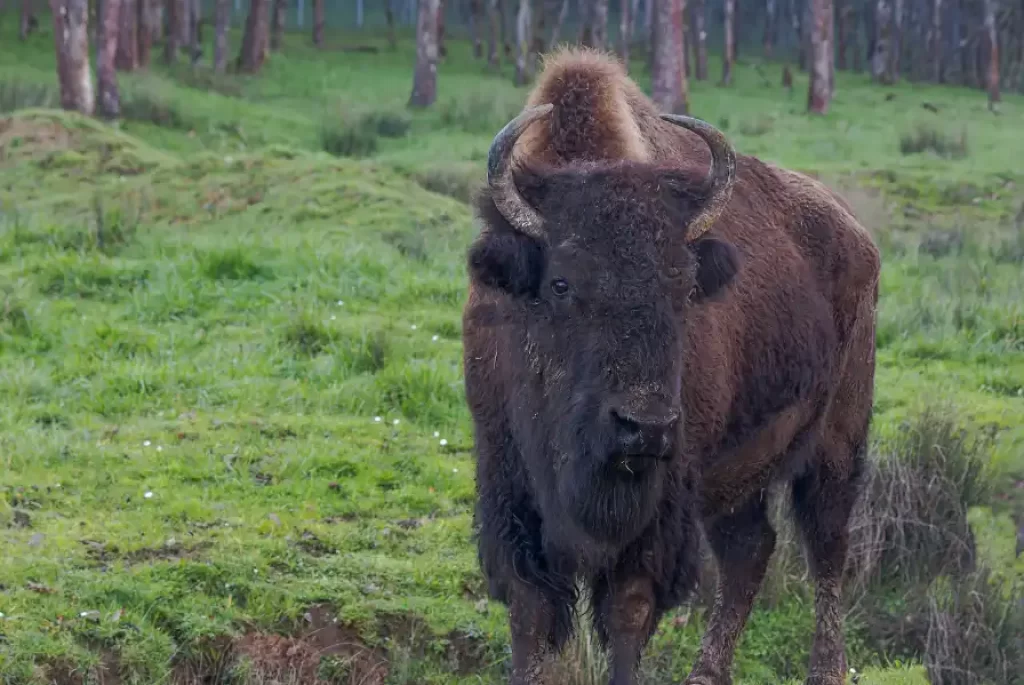
Bison are herbivores, which means that they eat plants. They have a varied diet that consists mainly of grasses, but also includes herbs, shrubs, and tree bark. In the summer, bison feed on fresh, green grasses, which are high in moisture and nutrients.
In the winter, when fresh vegetation is scarce, bison rely on dry grasses and shrubs, which are lower in nutrients but still provide enough sustenance to keep them alive.
They have a unique digestive system that allows them to extract nutrients from tough, fibrous plant materials. They have a four-chambered stomach that allows them to ferment and digest plant matter more efficiently.
The first chamber, called the rumen, contains bacteria and other microorganisms that break down the plant material. The partially digested food then moves to the other chambers of the stomach, where it is further broken down and nutrients are absorbed.
Bison require a diet that is high in fiber and low in fat in order to maintain good health. They also require access to clean water to stay hydrated, especially during hot summer months. In the wild, bison get all the nutrients they need from the plants they eat, but in captivity, they may be fed a special diet that includes hay, grains, and supplements to ensure that they are getting all the necessary nutrients.
Ecosystem Roles of the American bison
Grazing:
Bison are important grazers that consume large amounts of grasses, which helps to maintain the health and diversity of grassland ecosystems. Grazing bison help to prevent the growth of tall, woody plants, which can become invasive and outcompete grasses for sunlight, nutrients, and water. This can lead to a reduction in grassland productivity and biodiversity.
By keeping the growth of woody plants in check, bison help to promote the growth and reproduction of grasses, which in turn supports a variety of other plant and animal species.
Grazing by bison also helps to maintain the structure of grasslands, preventing the buildup of thatch and promoting the growth of new shoots from the base of grasses. This contributes to the overall health and productivity of the grassland ecosystem.
Soil cultivation:
Bison have a unique way of disturbing the soil with their hooves as they graze and move across the landscape. This creates bare patches of soil, which allows sunlight and rain to reach the ground, and also increases soil aeration and nutrient availability.
As a result, these bare patches provide ideal conditions for new plant growth, which helps to maintain the health and diversity of grasslands. Additionally, the bison’s manure contributes to the soil’s nutrient cycle, further promoting plant growth and soil health.
Seed dispersal:
Bison play an important role in seed dispersal, as they consume a variety of plants and their dung helps to distribute seeds across the landscape. As bison move across the grasslands, they deposit their dung in different areas, often far from the original source of the plant material they consumed.
This can help to promote plant diversity and maintain ecosystem health, as it allows seeds to spread and establish in new areas. Additionally, the nutrients in bison dung can help to promote the growth of the plants that sprout from the dispersed seeds, further contributing to the health and productivity of the ecosystem.
Overall, bison are an important component of seed dispersal in grassland ecosystems, and their presence helps to promote and maintain plant diversity.
Predator-prey relationships:
Bison are a key prey species for predators such as wolves and grizzly bears. Their presence in grassland ecosystems helps to maintain healthy predator-prey relationships, which are essential for ecosystem health and balance.
As predators hunt bison, they help to control the population size of the bison herd, which can prevent overgrazing and promote the growth and diversity of grasses and other plants.
Additionally, the presence of predators can help to promote herd health, as they tend to target weaker and older individuals, leaving the stronger and healthier animals to reproduce and pass on their genes. This can help to improve the overall genetic health and fitness of the bison population over time.
Cultural significance:
Bison have played an important cultural role for many Indigenous communities in North America, and their presence is tied to cultural practices and traditions.
American bison FAQ’s
What is the scientific name of the American bison?
The scientific name of the American bison is Bison bison.
How large are American bison?
American bison are large, heavy animals that can weigh up to 2,000 pounds and stand up to 6 feet tall at the shoulder.
Where do American bison live?
American bison are native to North America and can be found in grassland ecosystems across the United States and Canada.
What do American bison eat?
American bison are herbivores that primarily graze on grasses, but they will also consume other plant materials such as shrubs and tree bark in winter when grasses are scarce.
Are American bison endangered?
American bison were once nearly hunted to extinction in the 19th century, but conservation efforts have helped to increase their population size. While they are no longer considered endangered, they are still listed as a near-threatened species by the International Union for Conservation of Nature (IUCN) due to habitat loss and other threats.
What is the role of American bison in Native American culture?
American bison have played an important cultural and spiritual role for many Native American tribes, who relied on them for food, clothing, shelter, and other resources. Bison are often depicted in Native American art and storytelling, and many tribes continue to honor and respect their relationship with these animals.
Can American bison be domesticated?
While American bison have been domesticated in the past, they are generally considered to be wild animals and are not commonly kept as domesticated livestock. However, some bison ranchers do raise bison for their meat and other products.
Do American bison have any predators?
American bison have few natural predators, but they are sometimes preyed upon by wolves, grizzly bears, and mountain lions.
How do American bison communicate with each other?
American bison communicate with each other through a variety of vocalizations, body language, and scents. They use low-frequency vocalizations to communicate over long distances, and they also use body language such as head movements and ear positions to signal to other members of their herd. Additionally, they use scent marking to establish territories and communicate with other bison.
How fast can American bison run?
American bison are surprisingly fast and can run at speeds of up to 35 miles per hour over short distances.




